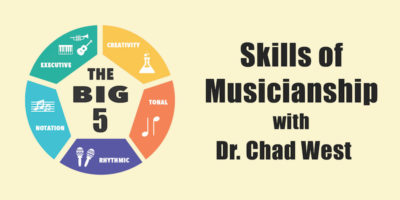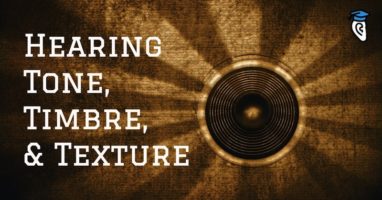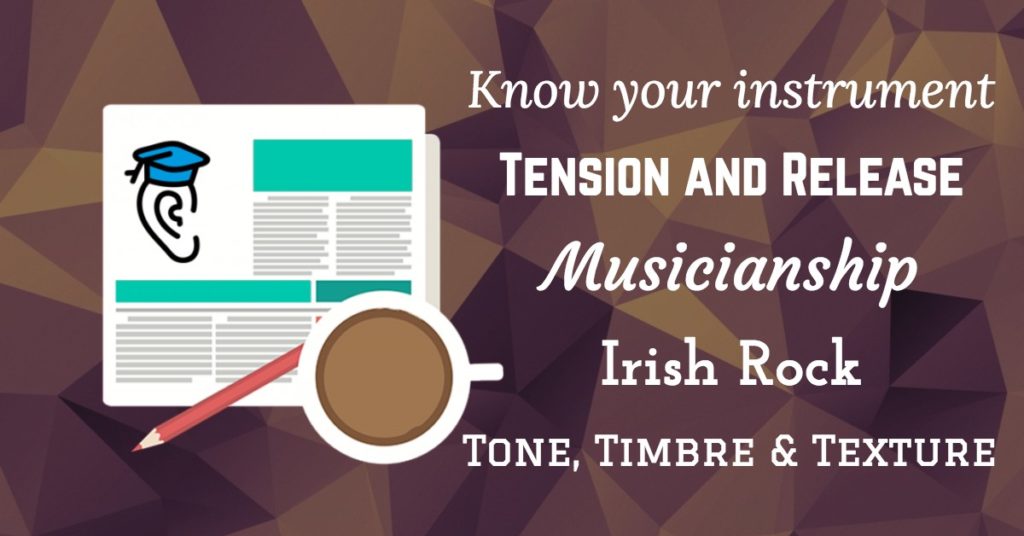Musicianship is a term that is commonly used but many musicians have only a loose understanding of. Find out what it takes to have true musicianship in our new interview with music education expert Dr. Chad West, and learn how knowing your instrument inside-out is one effective way to develop your musicality. Plus join us in actively listening to the difference between tone, timbre and texture and open your ears to Irish rock band the Elders.
We also have tips for you on how to include tension and release in your musical compositions to create hooks that will keep listeners engaged.
The “Big 5” Skills of Modern Musicianship
 Becoming a musician is much more than just learning to play an instrument but this isn’t always reflected in current music education practice. This week we spoke to Dr. Chad West who has defined the “Big 5” skills of modern musicianship with a focus on “internal musicianship skills”. Read on to find out how you can develop these skills to become a well-rounded musician.
Becoming a musician is much more than just learning to play an instrument but this isn’t always reflected in current music education practice. This week we spoke to Dr. Chad West who has defined the “Big 5” skills of modern musicianship with a focus on “internal musicianship skills”. Read on to find out how you can develop these skills to become a well-rounded musician.
Musicianship means many things to different people. Andrew R Brown answers the key question: what exactly is musicianship and how do you teach it? Having the right foundation for musicianship is essential and Dave Isaacs for Music Starts Here dives in with the important skills needed for good musicianship, especially listening and reacting.
Musicality means… Knowing Your Instrument Inside Out!
 For all of us at different stages of our musical journey, knowing our instrument inside-out is a key part of musicality. That means knowing how it was made, how it works, it’s history and most importantly how to get the best sound out of it. Find out how knowing your instrument contributes to your overall musicality and how Musical U can help you do it.
For all of us at different stages of our musical journey, knowing our instrument inside-out is a key part of musicality. That means knowing how it was made, how it works, it’s history and most importantly how to get the best sound out of it. Find out how knowing your instrument contributes to your overall musicality and how Musical U can help you do it.
Making music that moves people depends on knowing your instrument to this level. For more on this, David Santistevan explains how instrumental know-how can help you to communicate better musically.
Singers have a particular challenge in learning to know their instrument because their bodies are their instruments! Polish Jazz Singer Karo Glazer explains how the voice works like an instrument in this video:
Tension and Release
 Creating a captivating musical composition is all about TENSION and… release.
Creating a captivating musical composition is all about TENSION and… release.
This is what grabs the listener’s attention and keeps them engaged in the music. This week on the Musical U blog they have described the four ways to create this gradual increase in tension, followed by a sense of release. So read Tension and Release in Music to find out how you can use this technique in your own musical creations.
If you are looking for more ways to create tension and release you can read Subaqueous Music’s article on using the Circle of Fifths and Taming the Saxophone’s post on unity and variety in composition. And The Essential Secrets of Songwriting discusses how energy can create tension and release and compel the listener to keep listening.
Find the Tonic
 Being able to identify the tonic of a piece of music opens doors to many other musical skills such as playing by ear and transcribing any tune you hear in your daily life. Following on from our previous tutorials on finding the tonic in major key melodies, we now talk about finding the tonic in minor keys.
Being able to identify the tonic of a piece of music opens doors to many other musical skills such as playing by ear and transcribing any tune you hear in your daily life. Following on from our previous tutorials on finding the tonic in major key melodies, we now talk about finding the tonic in minor keys.
As discussed there:
- It’s helpful to know chord progressions in minor keys to help you find the tonic. If you are new to chord progressions in minor keys, Uberchord offers this tutorial for beginners.
- It’s important to know how to find the relative minor of a major key to help you find the tonic. Dave Conservatoire offers this video to help you learn to find the relative minor:
Tone, Timbre, and Texture
 The terms tone, timbre and texture are frequently used to describe how music sounds, but do you know exactly what they mean? Read our definitions and get tips on how to actively listen for each of these qualities in the music you hear everyday in Hearing Tone, Timbre, and Texture.
The terms tone, timbre and texture are frequently used to describe how music sounds, but do you know exactly what they mean? Read our definitions and get tips on how to actively listen for each of these qualities in the music you hear everyday in Hearing Tone, Timbre, and Texture.
For a closer look at the differences between tone and timbre don’t miss Take Lessons’ article Understanding Tone and Timbre.
Timbre’s role has sometimes been underrated or even ignored, because it’s so intangible. Hazlitt discusses timbre’s unique role in music.
And if you’re still left wondering what exactly is texture in music? Wakeland High School AP Music Theory defines the different types of musical texture with examples in this video:
Open Your Ears to The Elders
 This week we “opened our ears” to an Irish rock band, The Elders. Despite being from the American Midwest The Elders undoubtedly have a classic Irish rock sound. Actively listen to these five great songs and learn the characteristics of this much loved genre.
This week we “opened our ears” to an Irish rock band, The Elders. Despite being from the American Midwest The Elders undoubtedly have a classic Irish rock sound. Actively listen to these five great songs and learn the characteristics of this much loved genre.
If you are looking for more Irish Rock, check out this list of the best Irish Rock bands of all time by Irish American Mom and keep up on the latest news with The Point of Everything’s weekly round-up of all the latest news from the Irish music scene.
Now you should be all set to hear the tonic, tone, timbre and texture in all the music in your life. Your ears will have enjoyed some lively Irish rock, and you will have some ideas on how to include tension and release when writing music. And all these will contribute to developing the “Big 5” skills to help you become the musician you have always dreamed of being!







